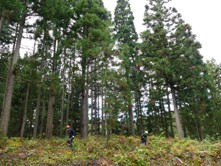- Home
- Sustainability
- Environment
- Conservation of Biodiversity
- Initiatives
- Forest development through cooperative work with stakeholders
Forest development through cooperative work with stakeholders
Aiming to contribute to the development of local communities, employees of the Ricoh Group have been working together with various parties, including local governments and local residents, on “forest development through cooperative work with stakeholders” since 2017. We work on activities to promote the restoration of satoyama, a rural landscape, with rich biodiversity and the revitalization of local communities.
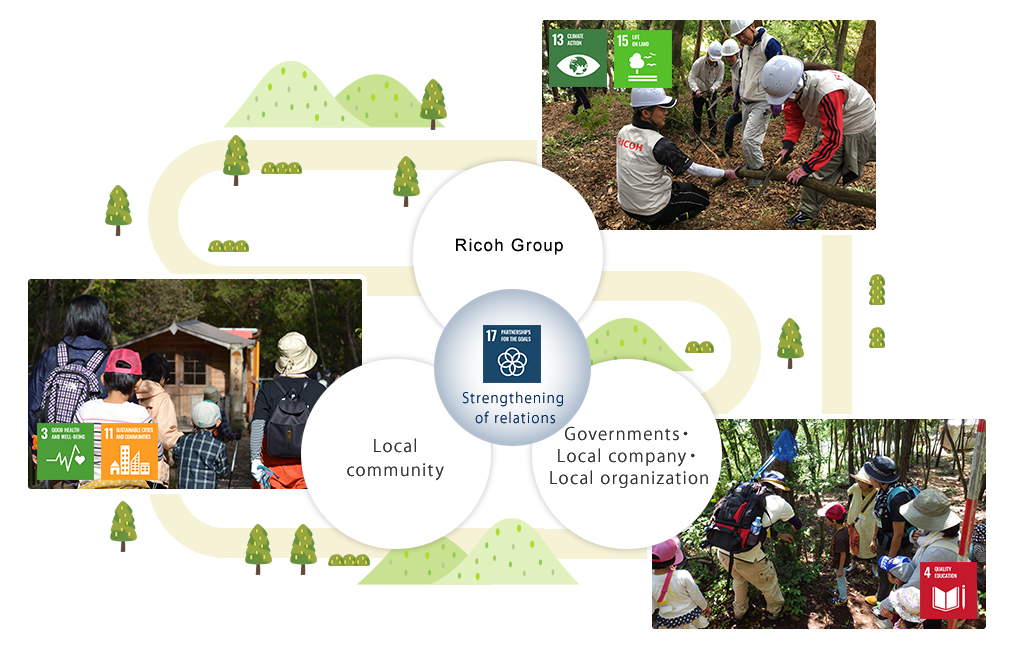
Ena forest project
Ricoh and local residents’ collaborative efforts to conserve Ena forest for future generations 100 or more years into the future
— Contribution to global environmental conservation, raising the next generation, and community development —
●Location:Japan, Gifu Prefecture
●Period:2014 ~ to present
●Activity : Aiming to create a local forest that can coexist with a rich natural environment in collaboration with local residents
The Ricoh Group has been engaged in activities to conserve a forest in Ena, a city in the southeast part of Gifu Prefecture. The forest is located on the premises of a plant operated by Ricoh Elemex Corporation, a manufacturing subsidiary of the Ricoh Group. Ricoh Elemex purchased the vast tract of land in 1963 to build its manufacturing plant. In addition to the site used for the manufacturing facilities, the acquired property includes a huge undeveloped area encompassing more than 40 hectares.The Ricoh Group started its forest conservation activities on this site in 2010 to mark the Tenth Meeting of the Conference of the Parties to the Convention on Biological Diversity (COP 10) held in Nagoya, Japan. The activities reflect our gratitude to the local community for its support of our manufacturing facility over the past almost 50 years as well as our commitment to maintaining harmonious relationships with our neighbors.
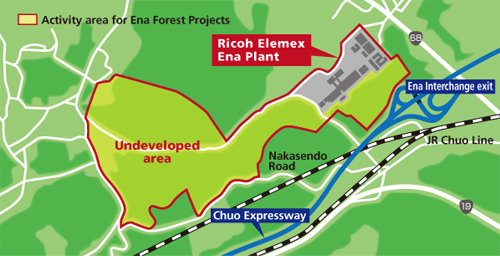
Biodiversity targets and evaluation of Ena Forest
<Target>
Aiming for a forest where diverse organisms can live by maintaining an ecosystem in which the target species, the luehdorfia butterfly and the scarlet dwarf, also known as the pygmyfly (Luehdorfia japonica, Nannophya pygmaea), can live.
<Actual results>
Since 2010, the habitat of the target species has been confirmed.
A vegetation survey conducted in cooperation with the C.W. Nicol Afan Woodland Trust in the fall of 2010 revealed that the forest near the Ena Plant is home to a wide variety of hygrophyte plant species, including some that are endangered, and that it has developed a unique ecosystem thanks to the lack of human interference over a very long period. Ricoh Elemex employees interested in conservation and some like-minded local residents started forest conservation activities in 2011. Later, in April 2014, aiming to utilize the precious forest resources together with the local community, we launched the Ena Forest, Nakasendo Satoyama Conference, which consisted of representatives from among local residents, local businesses, and nonprofit organizations as well as representatives of Ricoh Group companies. The organization has since been leading the efforts by local volunteers and Ricoh Group employees to conserve the forest and its rare species by forest management activities such as tree thinning. Participants in each volunteer activity event are rewarded with a gift certificate that can be used in shops operated by the Ena Tanpopo Social Welfare Organization, including a bakery, a produce store, and a local specialty store. As the forest is open to the local community, children also visit the forest to take part in educational programs where they learn about and connect with nature, while adults can enjoy relaxing walks through the woods.
Through these activities, the Ricoh Group will continue to make positive contributions not only to environmental conservation but also to the development of the next generation and the invigoration and development of local communities.
Goals of the Ena Forest Projects
Local forests where people can coexist with the rich natural environment
- A biodiversity including rare species is conserved.(Global Environmental Conservation)
Major activities: Removal of weeds and dead/damaged trees, and periodic vegetation surveys - Contribute to raising environmental awareness among local children(raising the next generation)
Major activities: Nature education programs for children, nature observation events, craft workshops, and training programs to develop forest conservation leaders - Enhance the lifestyles of local residents so they feel greater fulfillment, promote greater physical wellbeing, and contribute to community development
Major activities: Development of walking trails, forest management volunteer programs, and walk-for-health events
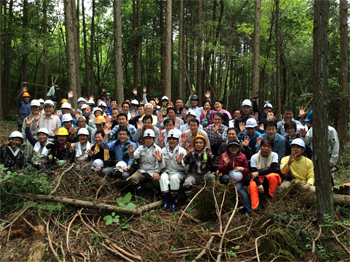
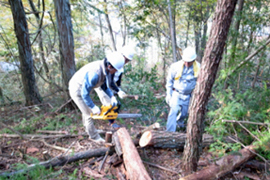
Forest management volunteer activity
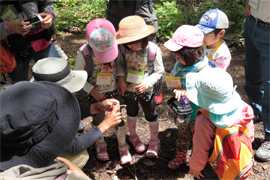
Children looking at a plant with curiosity
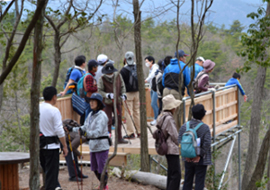
Local residents enjoying the
fantastic view from the
observation point during
a walk-for-health event
Surveys and Evaluations to Understand the Ecosystem
We regularly conduct large-scale vegetation surveys at Ena Forest to assess and improve the conservation status.
<Survey Report 1>
In a vegetation survey conducted in September 2010, 289 species of plants belonging to 85 families were identified, and six endangered species were recognized. The forest is mainly composed of fuelwood for charcoal production, such as the joicham oak (quercus serrata and sawtooth oak (quercus acutissima), although precious species such as bladderworts (utricularia caerosa), start magnolia (magnolia stellata), and alder tree inhabit the wetlands and their water sources. As for insects, scarlet dwarfs were found in the wetlands, and Japanese luehdorfia were found at the forest edge in early spring.
<Survey Report 2>
In the 2016 vegetation survey, 337 species of 96 families (more than in 2010) were confirmed, and 10 endangered species were also identified. Compared to 2010, the vegetation and its diversity has been maintained and is considered to be in the same condition or better. The naturalization rate has increased from 6.2% for 18 species to 7.7% for 26 species, and naturalized plants that were found only at the forest edge in 2010 can now be seen near the entrances and exits of forests and along their forest trails. Although this is not a major problem at present, we are carrying out conservation activities to prevent the growth of alien species caused by bringing in seeds from the outside. As a result of conducting an insect survey focusing on the target species, the Japanese luehdorfia and the scarlet dwarf, 28 species of dragonflies, 23 species of butterflies, 15 species of beetles, and 11 other species were confirmed. Since we did not conduct an insect survey at the beginning of the activity, we cannot compare these figures, but the target species of Japanese luehdorfia and scarlet dwarf tended to increase. The results of the vegetation survey and insect survey conducted in 2016 will be reported in a debriefing session for the people who participated in the live forest-building activity (conservation activity), and the results of the activity will be revealed to everyone who participated. It was a good opportunity to share the knowledge we gained and learn that it is a forest with abundant vegetation. These surveys are conducted in collaboration with local animal and plant conservation groups.
Ricoh Collaborative Forest Shimokumeda
●Location:Japan, Fukui Prefecture
●Period:2017 – to present
●Activity:Aiming to create satoyama where people, animals, and plants can coexist by preserving biodiversity through the maintenance of pristine forests.
In Shimokumeda, Fukui Prefecture, we are working to preserve biodiversity by maintaining an pristine forest and to create satoyama where people, animals, and plants can coexist together. We also plan to utilize this satoyama as a place for local communication and as a place for environmental education.
<Target>
- Collaborate with the Satoyama area of Shimokumeda, Sakai City.
- Contribute to the revitalization of the local community through exchange programs.
- Preserve satoyama by maintaining local forests rich in ecosystems indigenous to the area.
- Educating the next generation through activities and workshops in the satoyama
*This project is positioned as part of the activities of the comprehensive agreement with Sakai City.
<Specific Activities>
- Signed a 3-year agreement in 2017 with Sakai City, Shimomeda Satoyama Preservation Society, and landowners , and have been holding the event twice a year (spring and fall).
- Current activity time 9:00-12:00 activity.
- Programs to be implemented will be set in accordance with the season from the following contents.
Clear-cutting of satoyama and bamboo forest areas, underbrush picking, creation of walking trails, satoyama nature class
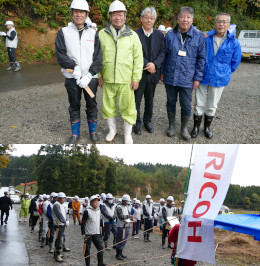
Collaboration with Sakai City, local organizations, and landowners
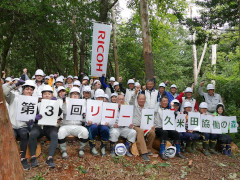
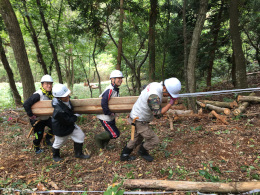
Maitaining forest
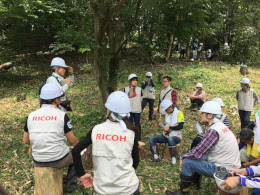
Lectures by local experts
Ricoh’s Forest Nirasaki
●Location:Japan, Yamanashi Prefecture
●Period:2018 – to present
●Acitivity:Aiming to preserve biodiversity and create a forest where local residents can both learn and enjoy by maintaining the forests in the natural park.
At Nirasaki City in Yamanashi Prefecture, the city regularly maintains forests in the city's natural park to preserve a biodiversity that will allow achievement of these aims
<Target>
- Contribute to the revitalization of the local community through cooperation and social exchange with the city of Nirasaki in Yamanashi Prefecture.
- Preserving local forests rich in indigenous ecosystems by maintaining satoyama.
- Educating the next generation through lectures and workshops in cooperation with local environmental groups.
<Activities>
- Signed a forest maintenance agreement in 2010 with Nirasaki City and have been holding the event twice a year (spring and fall).
- Current activity time 9:00-12:00
- The following activities are carried out depending on the season and maintenance conditions
Undercutting of forests, thinning, conservation of azaleas, etc.
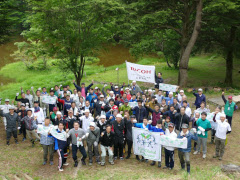
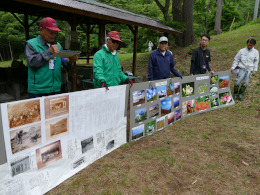
Lecture by local environmental group
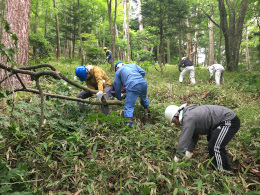
Maitaining forest
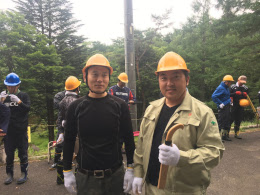
Collaboration with local governments and customers
Forest of Yanbaru
Creating a habitat for the butterflies
●Location:Japan, Okinawa Prefecture
●Period:2016 – to present
●Activity:Sustainable preservative activities of the butterfly habitat in Yanbaru forests.
Since 2001, the Ricoh Group has been supporting the Yanbaru Forest Conservation Project to protect the Yanbaru Forest, which is rich in ecosystems, and to help develop the region. In 2016, the Yanbaru forest was registered as a national park, and in 2021 as a World Heritage site. In 2016, the Ricoh Group launched a new project to create a habitat for butterflies through activities in cooperation with the local community.
<Target>
In cooperation with Ogimi Village, Okinawa Prefecture, and local organizations, we will preserve the habitat of more than 60 species of butterflies reported to live in the area.
*This project will be implemented as part of the activities of the comprehensive agreement with Ogimi Village.
<Activities>
In cooperation with Ricoh Group employees, their families, local organizations, residents, and students, we aim to create a “Satoyama Butterfly Garden” where people can experience the rich nature of Yanbaru through weeding along the Ogimi Village roadside, planting and preserving sandangka and hibiscus and other plants that will help butterflies grow.
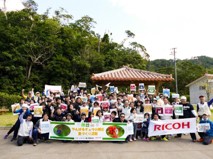
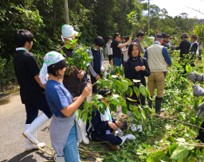
Collaboration with Gakushuin University
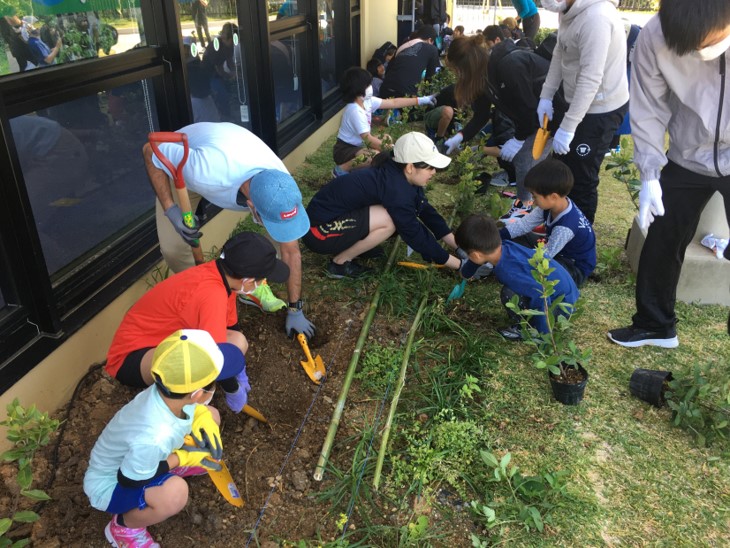
Planting trees to conserve butterflies
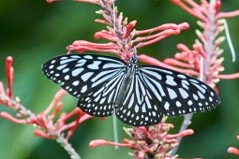
Donguriko-no-mori Forest
●Location:Japan, Saga Prefecture
●Period:2019 – to present
●Activity:Aiming to create a forest rich in local biodiversity as well as to protect water sources.
The name of the activity is “Donguriko-no-mori,” which is a combination of “Donguri (acorn tree) ” and “Ricoh,” and the name of the activity was solicited from the employees.
<Target>
We initiated this activity in cooperation with Saga City, aiming to contribute to the SDGs by protecting local acorn trees and creating a forest rich in biodiversity, as well as protecting Saga's water sources.
<Activities>
In collaboration with Ricoh Group employees and their families, Saga Prefecture, Saga City, local companies, and local organizations, we regularly conduct conservation activities such as tree planting, weeding around the forest, pruning, removing fallen trees, chipping and spreading wood removed in the thinning process on forest roads. In addition, we organize environmental lectures by instructors.
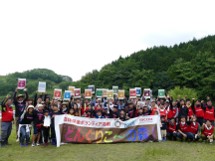
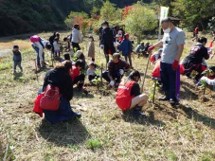
Planting trees
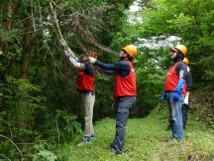
Maintaining forest
Kanmu-Ricoh’s Forest
●Location:Japan, Yamaguchi Prefecture
●Period:2022 – to present
●Activities:Preserving satoyama which is rich in biodiversity in Hikari City.
<Target>
Hikari City, B:Crew Esse, and the Ricoh Group are working together to “create a satoyama (village) harmonizing with the rich nature of the hometown Hikari” through forest maintenance at the Kanmuriyama Park.
<Activities>
The residents of Hikari City, Ricoh Group employees and their families regularly carry out preservation work such as tree planting, weeding in the area around the forest, pruning of trees, and removal of fallen trees and other debris. Kanmuriyama Park, which will be the main activity field under this agreement, is the only comprehensive park in the city where people can take a break to enjoy flowers and trees throughout the year. The ume (Japanese plum) blossoms in early spring are particularly popular. In addition to the ume village, the park has a children's forest, a spacious lawn, a Japanese garden, and an auto-camping area, where anyone can enjoy the rich natural environment.
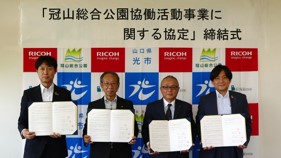
Agreement signing ceremony
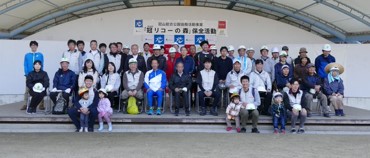
First forest maintenance gathering
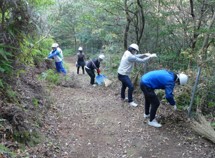
Maintaining footpath and forest
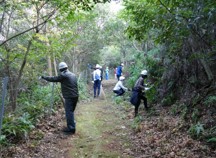
Ricoh Nanairo-no-mori forest
●Location:Japan, Yamagata Prefecture
●Period:2022 – to present
●Activities:Forest preservation activities to bequeath Yamagata City's rich natural environment to the future
<Target>
In collaboration with Yamagata Prefecture and the Monden Production Forestry Association, the project aims to achieve “forest maintenance to bequeath forests to our future in a healthy condition, and to revitalize the community by connecting companies, communities, etc. with many bonds through the activities” promoted by Yamagata Prefecture.
<Activities>
(1) Targets of activity
Contribute to local environmental preservation through reforestation.
Contribute to the development of the local community through bonding with the local community by reforestation.
We will work to achieve the seven goals of the Sustainable Development Goals (SDG 7, 8, 11, 13, 14, 15, and 17) and act as a company where employees themselves are actively involved in local environmental preservation and aim to create a sustainable society.
(2) Activity items
Forest preservation (trimming, undercutting, etc.), cleanup activities, and maintenance of forest trails.
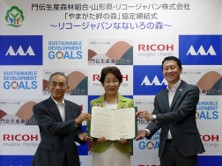
Agreement signing ceremony
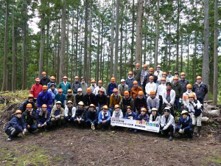
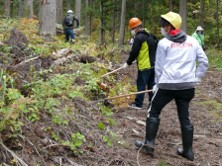
Maintaining forest
